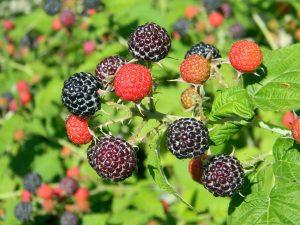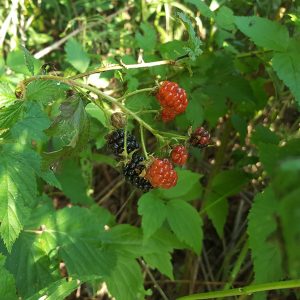Picking blackberries has always been one of my favorite summer pastimes. It seems like the season lasts forever and there are always tons of places to find them growing. It didn’t dawn on me until recently that it’s actually pretty strange how plentiful the fruit is and how long the season lasts.
I purchased a wild fruits and berries field guide a couple of weeks ago because of my daughter’s interest in foraging. I thought she would learn so much from it, already having an interest. Turns out, I have a lot to learn too.
One of my first discoveries was that not all black berries are actually blackberries. In Northeast Ohio, we are actually fortunate enough to have blackberries, black raspberries and black dewberries. Just as one berry’s season is coming to an end another is already beginning. As long as you can beat the birds, you can probably find fresh black berries all summer long.
Early to midsummer
Black raspberries are the first of the black berries to ripen in early to midsummer. This is generally the end of June or beginning of July. If you’re lucky, you may be able to find them throughout July — we found some last week — but it’s unlikely the birds will leave them alone that long.
Where they grow

Black raspberries grow in disturbed areas — logged areas; open woods; meadows; along streams, lakes, trails and roads. Our honey hole runs along the outskirts of a cornfield, up against a wooded area.
What they look like
Although it’s easy to mistake black raspberries for other black compound fruits, they do have their own distinguishing qualities.
Plant. Black raspberries grow in brambles — sprawling, vining shrubs. Their canes (stems) can grow up to 6 feet long and generally arch. The round canes have sharp curved thorns.
Leaves. Black raspberry plants have alternate compound leaves. The leaves usually have three leaflets, or sometimes five, with the center leaflet extending on a stemlet. The other leaflets attach directly to the stem. The leaflets can be distinguished by toothy edges with a pointed tip and round base. The leaves can grow up to 3 inches long.

Fruit. Black raspberries are distinguished from other black compound fruits by their more tightly clustered flesh; the appearance of finer, more numerous white hairs and a hollow center. They will grow up to 1/2 inch across, turning from green to yellowish to salmon to bright red to purple to purplish-black over the course of the ripening process.
Midsummer
Although black raspberries can be found into midsummer they are usually not as plentiful as black dewberries, which are fully ripened and plentiful throughout July.
Where they grow
There are so many varieties of native black dewberries, that they can be found in many different places. The two most common varieties are the swamp and smooth dewberries. The swamp dewberry likes to grow in and around bogs, as it’s name suggests. The smooth dewberry has similar preferences to the black raspberry. It prefers fields, forest clearings, thickets and streambanks.
What they look like

Plant. Although black dewberries share habitats with both black raspberries and blackberries, they grow very differently. Rather than rising erect, like the other two plants, dewberries sprawl along the ground forming a low-growing, vining shrub. Their stems are woody but weak, and they often develop roots. Smooth dewberry stems have curved pickles, while swamp dewberry stems are covered with fine bristles.
Leaves. Like black raspberries and blackberries, black dewberries have alternate compound leaves, but the shape of its leaves are unique. They are usually hairy to touch and about three inches long. They are more rounded near the top than the other two plants and they have sharper teeth around the edges.

Fruit. Black dewberries look a lot like blackberries, but their fruit is slightly smaller at 1/4 to 1/2 inch across. Unlike blackberries; however, they have a hull and are hollow when picked. In this aspect, they resemble black raspberries. During the ripening process, dewberries go from green to red to glossy black or purplish-black.
Mid to late Summer
As black dewberries become more sparse later in summer, blackberries are just arriving at peak season.
Where they grow
Blackberries, like both black raspberries and black dewberries, prefer to grow in disturbed areas along fields, pastures, forest clearings, thickets, paths, roadsides, streams, ponds and lakes.
What they look like

Plant. Blackberry plants are the largest of the three. They grow in brambles like black raspberries, forming sprawling, vining shrubs. However, they are much larger plants with canes that grow up to 8 feet in length. Their canes are also distinguished by being more rigid than black raspberry canes with a star-shaped cross-section rather than a round one. They also have more thorns than black raspberries.
Leaves. Blackberries, like black raspberries and black dewberries, have alternate compound leaves. They look a lot like black raspberry leaves especially, with toothy edges, sharply pointed tips and round bottoms. The leaves also contain three to five leaflets with a longer center leaflet extending on a stemlet, like the black raspberry. However, instead of three inches, blackberry leaves grow up to five inches long.
Fruit. Blackberries are about a 1/2 inch across and somewhat longer than black raspberries and dewberries. The other distinguishing feature is that the fruit is not hollow. The core remains inside the picked blackberry. During their ripening process, blackberries go from green to red to glossy black.






















Thank you for the informative article. I am interested in finding a speaker who could present a program at Salem Public library in Salem, OH about blackberries and other berries. Could you suggest a resource to find a speaker or could you suggest a person close to Salem, OH who could present a talk.
Thank you for your time and assistance.
Teresa Rhodes
Marketing and Outreach Coordinator
Salem Public Library
I would contact the Columbiana Soil & Water Conservation District to see if anyone there would be willing to put together a presentation or if they can point you in the direction of someone in the area who would.
Here is their info:
Columbiana Soil & Water Conservation District
1834-B South Lincoln Ave
Salem, Ohio 44460
330.332.8732
Hours: Monday-Friday 7:30 a.m. – 4 p.m.
I’m interested in the book you got about berries. I am in my first summer in our new house and we have five+ acres with berries all over. Some might be black dewberries, but I’m not sure.
Do black raspberries grow in warm climates like here in North Carolina or are they primarily native of cooler environments like Ohio or Pennsylvania?
What soil type do they prefer; sand, silt or clay?
Black raspberries do grow in North Carolina. They are common in the mountains, but scarce in the central region and coastal plain of North Carolina. They can be found along roadsides, in woodlands and in disturbed areas with partial sun and moist, highly organic soil.
Nice article, thank you! I’m going to have to examine the nearby plants to see which type they are. Probably dewberry, which I’d never heard of before, despite living in NE Ohio for decades!
I love canned blackraspberry my mother would open a can and pour the juice and berry’s on vanilla ice cream
We’re can I buysome
I know this is an old thread, but I have a black raspberry patch that I have been cultivating for a few years now, and thanks to my efforts pruning, weeding, and mulching, my patch has grown from a few straggler canes to a patch that will produce over a pound of berries a day at peak very reliably (bird netting and fencing works wonders).
There are a few things that I’ve observed, one that I haven’t seen anywhere else. The secret nobody else knows about black raspberries, is that the VERY FIRST harvestable black raspberries always occur on the day of the SUMMER SOLSTICE. Thats a super secret you heard here first. Check it and see for yourself. The day before, check your patch. You will see some ALMOST starting to turn over. The next day (the solstice) go check again. You will have black raspberries ready to pick. Black raspberries are a solstice calendar.
There is also an interesting biochemical process at work in black raspberries. The reason black raspberries are red is because they are ACIDIC to protect the seeds during formation. Thus is why animals don’t eat them when they’re red. The turning black is actually a biochemical shift from acidic to neutral and then slightly basic.
This can be explored by using mashed up black raspberry to make home made litmus paper. Mash up a few berries and add some water. Strain the matter through a coffee filter so you have fairly clear ‘berry water’. Dip some pieces of paper in the berry water and allow to dry.
Take your home made litmus paper, and put a drop of vinegar on it and watch it turn red. Then dip it in a solution of baking soda and water and watch it turn blackish purple.
This is a fun and interesting way to teach your kids or grandkids a little about plants, about their life cycles and defense mechanisms, and about chemistry, and how it works in nature, and how we can learn to use that knowledge as a tool.